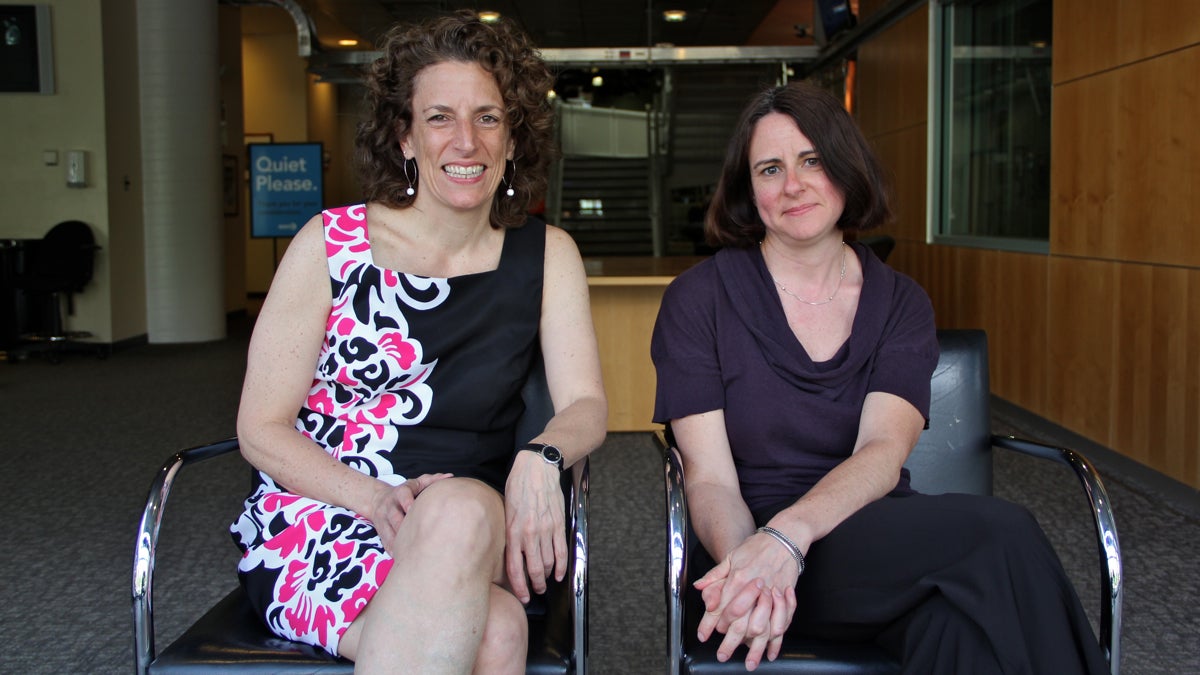Scientist applies her skills to understand art’s true chemistry
Listen
Christine Filippone (left) is assistant professor of art history at Millersville University. Dr. Melinda Keefe (right) is a senior research scientist at Dow. (Emma Lee/WHYY)
For our series “So what do you do,” Mindy Keefe sat down with Millersville University art historian Christine Filippone to talk about her work restoring modern paintings.
Mindy [Melinda] Keefe always wanted to be an artist, and was accepted into several art programs when she started college. But she wasn’t quite sure she was good enough, or if she would ever be able to make a living. She chose science, but was able to stay true to her artistic roots; she’s now a chemist who is passionate about paints.
Keefe works for Dow Chemical, and has forged relationships with the art restoration community to help restore modern paintings.
For our series “So what do you do?,” down to earth conversations about research and science – she sat down with Millersville University art historian Christine Filippone to talk about her work.
Filippone asked her how she started getting interested in restoring modern paintings.
“I’m a research scientist who makes paint, so I was interested in the intersection of the science of coatings and paints, and the paints used in art work,” Keefe explained. “When you think about a modern painting and the paint on your wall, it is the same technology and has the same challenges.”
Keefe told Filippone that she still paints at home, though she doesn’t have as much time for her own art work since her children were born. “I do mostly crayons and fingerprints,” she joked. “But with special insight into that fingerprint,” replied Filippone.
Filippone was especially interested in Keefe’s role in the restoration of a painting by Mark Rothko, which had been vandalized with graffiti ink at The Tate in London.
“One of the challenges about art conservation is that every piece is different, each has its own mixtures in terms of raw materials and what it has been exposed to,” explained Keefe. “There is not going to be one perfect solution, but we could find one that is well suited for your needs. You don’t want to do anything that will harm the painting or the integrity of the art.”
Keefe said the challenges of restoring a painting are similar to trying to clean spots or splotches off wall paint – it’s hard to rub them off without changing the appearance, the gloss or intensity of the paint.
Filippone mentioned that restoration can be controversial for that reason, citing the example of the Sistine Chapel frescoes by Michelangelo, which some critics say were ruined by the process.
“I’m not a conservator,” said Keefe. “But they are a very conservative field, for the most part, and for good reason, but things get dirtied and harmed and we have to find a solution,” she added. “So we’re trying to find out what are the safest approaches to removing the soil without changing the appearance of the artwork.
To help clean up the Rothko painting, Keefe had samples of the graffiti ink sent to Dow’s labs. “We did quite a bit of analysis with our special software to analyze the properties of the ink, and using our software, we could then predict which solvents would be best for this ink.”
Keefe came up with a list of 16 solvents that she and her team thought were good candidates, and one of them was used by conservators as they cleaned up the painting.
“Rothko’s work poses special challenges because he paints thin layer upon thin layer and he introduces different paints,” said Filippone.
Keefe agreed – and explained that the painting, which is unofficially titled “Black on Maroon,” had several layers of glaze in the black portions, which offered protection. “The maroon area did not have that, and the graffiti ink went right through the paint.”
Keefe also had some questions for Filippone. For example, she wanted to know if artists who are excited about the variety of materials available today know what that means for conservators.
“You mean, to make conservators’ lives more difficult?” joked Filippone. “Yes,” said Keefe.
“There are works of art now that are made of edible materials,” agreed Filippone. “Sculptor Janine Antoni makes art using materials like cholocate or lard, and those poor people in the conservation labs at those museums, they have a difficult task in front of them,” she said. “So, it’s absolutely critical to the field.”
Keefe and Filippone have stayed in touch since this conversation, and Keefe has agreed to come speak at one of Filippone’s seminars.
WHYY is your source for fact-based, in-depth journalism and information. As a nonprofit organization, we rely on financial support from readers like you. Please give today.




